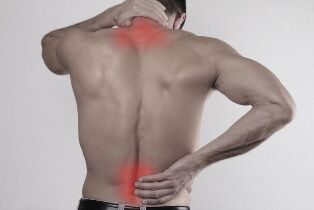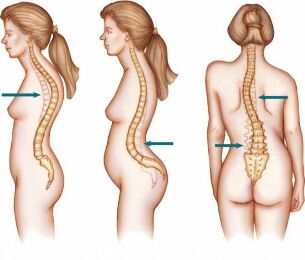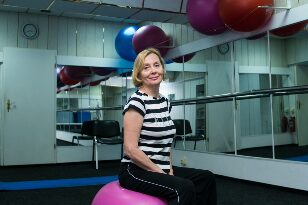Back pain is one of the most common complaints among people ages 25-30. They can arise not only as a result of overwork, but also act as a symptom of diseases of the spine or internal organs. Therefore, it is important to be attentive to your health and not ignore the problem. After all, if back pain is triggered by the appearance of pathological changes in the spine, it can ultimately lead to serious complications and even disability.

Reasons
In a number of situations, the back hurts for natural reasons: after strenuous physical work, hard training, a long walk in high heels, etc. In such situations, the pain is caused by the formation of lactic acid in the muscles, and in especially difficult cases, and micro-tears. muscles, sprains. Therefore, to eliminate them, it is necessary to give the back rest for several days.
Pregnancy is a common cause of back pain. Since the body undergoes many changes, especially in the later stages of pregnancy, it can respond to this with pain in the lower back. If they are not acute and are not associated with lower abdominal discomfort or the appearance of unusual secretions, it is considered a normal variant. But at the same time, ongoing changes, a change in the center of gravity and an increase in the weight of a woman during pregnancy can provoke an exacerbation of chronic diseases or become the cause of the development of degenerative-dystrophic changes in thespine.
Due to the fact that during pregnancy the load on a woman's body doubles, it is very important to order the column. Our clinic has developed and prepared a special comprehensive examination and treatment program for pregnant women and those planning a pregnancy.
It is degenerative-dystrophic processes, as well as other pathologies of the spine, which most frequently cause back pain in women and men over 30 years of age. With them, the pain can be located anywhere in the back (neck, between the shoulder blades, in the lower back) and reach the head, shoulders, arms, buttocks, legs, etc. It can be of varying severity, be sharp, stabbing, pulling, painful, constantly present, or occur after physical exertion. All of these are important signs that help determine the cause of the development of pain syndrome, and therefore find an effective way to eliminate it.
The most common diseases associated with back pain are:
- Osteochondrosis, bulges and intervertebral hernias;
- curvature of the spine (kyphosis, scoliosis, lordosis and their combinations);
- myofascial syndrome.
With some less frequency, back pain is caused by compression fractures of the spine (typical of the elderly or people who have suffered injuries, falls from a height, an accident), the development of ankylosing spondylitis, spondylosis, spondylolisthesis and other diseases of the spine.
In addition, pain in different parts of the back can be caused by the appearance of disorders in the work of internal organs. For example, pain in the neck can accompany pathologies of the thyroid gland, inflammation of the lymph nodes, diseases of the blood vessels and back pain can indicate a pathology of the kidneys, pelvic organs and gastrointestinal tract. . Discomfort in the middle of the back, in the area of the shoulder blades is quite rare, but it also occurs. Its appearance, in addition to diseases of the spine, may be due to the appearance of disorders in the work of the heart, etc.
But the essence of the problem lies in the fact that diseases of the internal organs do not arise out of nowhere. They almost always become theresult of a violation. Segmental innervation, that is, the quality of transmission of nerve impulses from the spinal cord through the nerve roots and branches of the nerves to specific organs. Each level of the spinal cord has its own pair of spinal roots, from which the nerves branch off and go to the corresponding organs. If there are changes in the spine, for example, curvatures, displacement of the vertebrae, changes in the height and condition of the intervertebral discs, this inevitably affects the condition of the spinal roots and spinal cord. Various vertebral structures can tighten or even injure them, as they change their natural parameters and position. Thus, nerve impulses pass worse to the organs, which leads to the appearance of at first insignificant, but constantly progressive disturbances in their work. Gradually, organic changes appear in the organs, which becomes the cause of the development of the disease. Therefore, in case of back pain and the detection of pathologies of internal organs, it is imperative to examine the spine and find the changes that provoked its development. The impact on them will increase the effectiveness of the treatment of internal diseases, and, most importantly, eliminate the prerequisites for their appearance.
Each spinal movement segment has its own pair of nerve roots that transmit signals to a specific organ.
Osteochondrosis, protrusion and intervertebral hernia
Osteochondrosis is the most common disease of the spine, occurring in one in two adults at different stages of development. It is accompanied by degenerative-dystrophic changes in the intervertebral discs, that is, their gradual destruction.
Depending on what part of the back pain occurs and, consequently, degenerative-dystrophic processes in the intervertebral discs, osteochondrosis of the cervical, thoracic and lumbar spine is distinguished. Most often, the discs of the lumbosacral spine are destroyed, less often - the cervix, and only in rare cases is osteochondrosis of the thoracic spine diagnosed.
For osteochondrosis, the pain is typical, initially weak, painful after physical exertion or prolonged session. They gradually intensify and occur with increasing frequency. Over time, the discs become so exhausted that their outer layer cannot support the loads placed on it and becomes deformed, that is, a bulge is formed that eventually becomes a hernia. In the latter case, the annulus fibrosus is completely ruptured and the internal contents of the disc can fall into the spinal canal.
In both cases, the protruding parts can squeeze the spinal roots, thus causing the development of root syndrome. This means that in addition to the fact that the pains will be sharp and strong, they will also be given to the arms, legs, buttocks and other parts of the body, which directly depends on which disc is deformed. So when the nerves of the cervical spine are pinched, the pains tend to occur in the shoulders and arms, and when the nerves of the lumbar spine are compressed, in the buttocks and legs. This is often accompanied by sensory deficits, including numbness, a dragging sensation, and gradual muscle atrophy.
The disease is fraught with irreversible changes in nerve fibers, which can lead to paralysis and disability.
Curvature of the column
The curvature of the column can be observed in any part of it. A perfectly flat spine today is a rarity, therefore almost all modern people have more or less pronounced deformities. This could be:
- kyphosis: strengthening of the natural curvature of the spine in the cervicothoracic region;
- lordosis: increased natural deviation of the spine in the lumbar spine;
- scoliosis - lateral deformity of the spine.
In each case, curvature can cause compression of various groups of nerves, which will also lead to root syndrome. But if with osteochondrosis the changes in the initial stages of development are visually impossible to overcome, the deformities of the spine can be easily diagnosed by the asymmetry of the position of the shoulder blades, pelvic bones, the protrusion of the abdomen or the formation ofa hump.

Myofascial Syndrome Myofascial syndrome is not a dangerous, but rather a painful condition in which certain muscle groups spasm in response to pressure or physical activity. Therefore, if, against the background of absolutely normal health, you press on the place where back pain usually occurs, you may get a new attack of acute pain, which is an important diagnostic criterion.
Diagnosis of the causes of back pain
If back pain occurs, regardless of whether it is in the neck, between the shoulder blades or in the lumbar region, it is recommended to consult a neurologist. An appointment with a chiropractor, vertebrologist, and neurologist is necessary as soon as possible if the pain radiates to other parts of the body, as this is a sign of the development of root syndrome.
Our center specialists use an integrated approach to diagnosis and treatment, so they can quickly make the correct diagnosis. Diagnosis begins with a survey of the patient, during which the nature of the complaints presented, as well as the characteristics of work and rest, is clarified. The doctor must carefully examine the patient, palpate the spine, as well as conduct special functional and neurological tests. This allows you to form a complete picture of the patient's condition, detect signs of neurological deficit, and assess the degree of damage. To clarify the diagnosis, it is mandatory to appoint:
- X-ray examination;
- CT;
- MRI.

If there are no contraindications, MRI is always preferred, as this method can provide the most comprehensive data on the state of the spine and especially its discs, allowing even minor changes in its condition to be diagnosed inthe earliest stages and intervene in a timely manner in the pathological process.
In our clinic, you can also learn more about the composition of your body and the state of the vascular system, which is involved in the blood supply to internal organs, musculoskeletal muscles and the brain. Our experienced doctors will explain the findings to you in detail. Bioimpedansometry calculates the ratio of fat, muscle, bone and skeletal mass, total body fluid, and basal metabolic rate. The intensity of the recommended physical activity depends on the state of the muscle mass. Metabolic processes, in turn, affect the body's ability to recover. Based on the active cell mass indicators, the level of physical activity and nutritional balance can be judged. This simple and quick test helps us see endocrine disturbances and take action. In addition, it is also very important for us to know the state of the blood vessels for the prevention of diseases such as heart attacks, hypertension, heart failure, diabetes mellitus and much more. Angioscan allows you to determine such important indicators as the biological age of blood vessels, their stiffness, stress index (which speaks of heart rate), oxygen saturation in the blood. This screening will be useful for men and women after 30, athletes, those who are in a long and difficult treatment, as well as for all those who monitor their health.
If the diagnosis shows that the back pain is the result of the development of diseases of the internal organs, the patient is referred to specialists as limited as a urologist, endocrinologist, gynecologist, gastroenterologist, cardiologist, etc.
Body composition analysis gives us information on the amount of adipose tissue in the body and the musculoskeletal component. These data will help the rehabilitation physician to correctly develop a physical activity plan, taking into account the individual characteristics of the patient.
Treatment of back pain
Treatment of back pain is always complex, since it is impossible to eliminate pathological changes in the spine only with the help of drugs. At the same time, for each patient, the therapy regimen is developed strictly individually. Not only the diagnosis and stage of development of the disease are taken into account, but also the presence of concomitant diseases, the age of the patient, her work habits and characteristics, the level of physical fitness and other factors. Therefore, even in patients with the same diagnosis, treatment can be carried out in different ways. Only this approach gives the maximum results.
So, the main components of conservative therapy for vertebrogenic back pain are:
- drug therapy;
- osteopathy;
- manual therapy;
- massage;
- physiotherapy (phonophoresis, carboxytherapy, ozone therapy, pressotherapy, RF currents);
- individual lesson with a rehabilitation doctor.
Spinal surgery is indicated only in very advanced cases with absolute ineffectiveness of conservative treatment.
Patients are strongly advised to reduce weight as much as possible, as well as to avoid excessive physical exertion as well as a sedentary lifestyle. A balanced diet will further enhance the effect of the treatment.

Drug therapy
Drug therapy can include drugs from different drug groups, depending on a combination of several factors. In the vast majority of cases, patients are prescribed:
- NSAIDs;
- corticosteroids;
- muscle relaxants;
- chondroprotectors;
- B vitamins;
- vitamin D.
Patients with very severe radicular pain that cannot be treated with non-steroidal anti-inflammatory drugs or pain relievers may be offered blocks. The procedure involves the introduction of a lidocaine or novocaine solution, sometimes in combination with corticosteroids, directly into the area where the compressed nerve passes. They do not have a therapeutic effect, but they allow you to quickly eliminate even severe pain of neurological origin. But the implementation of locks requires special skills and absolute sterility, since such injections can lead to the development of serious complications.
Manual therapy
Manual therapy is rightfully considered one of the main components of the treatment of back pain of various origins, allowing you to restore the normal anatomy of the spine and at the same time:
- to improve the quality of transmission of nerve impulses along the peripheral nerves to all organs of the human body;
- activate blood circulation and lymphatic flow;
- start the body's natural recovery processes and create favorable conditions for their course;
- strengthens immunity and increases the body's ability to adapt to new living conditions, etc.
The use of special manual action techniques directly on the spine and surrounding tissues allows pressure to be removed from various anatomical structures on the spinal roots, leading to the elimination of pain, including those radiating to the extremities andother parts of the body. In addition, with their help, it is possible to increase the distance between the vertebral bodies, which provides the most favorable conditions for the restoration of deformed vertebral discs, and active kneading of the muscles helps to eliminate functional blockages, increases mobility andthe flexibility of the spine and accelerates the course of metabolic processes.

We do not have common treatment standards, we apply an individual approach to each patient. Gritsenko's author's technique has shown high efficiency over the years of use. It involves a special effect on the spine, because not only do back pain disappear, but the causes of its appearance are also eliminated. And the normalization of the segmental innervation of the spinal cord helps to improve the functioning of the internal organs and to eliminate the causes of the progression of their diseases.
Therefore, patients with back pain can expect pronounced positive changes after 1-2 sessions of manual therapy according to the method of the author of Gritsenko. The number of procedures that will be required to obtain the maximum possible result and their consolidation is selected individually for each patient.
Physiotherapy
Physiotherapy treatment is prescribed outside the acute period of the disease. With its help, it is possible to enhance the effect of other methods of influence. As a rule, patients are prescribed courses of procedures characterized by anti-inflammatory, analgesic and antispasmodic properties, namely:
- electrophoresis;
- traction therapy (spinal traction);
- UHF;
- laser therapy;
- ultrasound therapy, etc.
exercise therapy
Physical therapy is not the last component of back pain management. The stability of the result depends largely on the regularity and correctness of its implementation, since exercise therapy is aimed primarily at strengthening the muscular corset of the back, which will create support for the spine and reduce the load on the intervertebral discs. . In addition, exercise therapy helps to improve the quality of blood circulation, which leads to a more active supply of drugs and nutrients to injuries, increasing the effectiveness of therapy.

But choosing a set of exercises on your own is not recommended, as performing the generally recommended exercises can harm the patient due to overstressing certain muscle groups. Therefore, the development of the optimal complex should be entrusted to a rehabilitating doctor, who will teach a person how to correctly perform each exercise.
Therefore, although back pain is familiar to all adults, it is not worth considering it harmless. Such negligence can result in severe complications and, at best, can be treated surgically. In the worst case, the patient faces a disability. Therefore, if back pain occurs with enviable regularity or is rather acute, make an appointment with a neurologist and find out the true cause of the discomfort. After all, the disease is much easier to stop in the early stages of development.

























